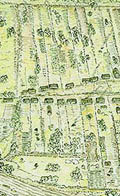![]() The
English Village at the time of the Domesday Book
The
English Village at the time of the Domesday Book
 In
most parts of the English countryside the Norman Conquest brought about no
radical changes, although the population acquired new landlords. The great
survey of landholding, the Domesday Book of 1086, reveals a country divided
up into local government units known as manors, each ruled by a manorial lord
who ultimately held his land from the king himself. In most parts of England
Domesday Book implies that each manor contained one, but sometimes more than
one, village.
In
most parts of the English countryside the Norman Conquest brought about no
radical changes, although the population acquired new landlords. The great
survey of landholding, the Domesday Book of 1086, reveals a country divided
up into local government units known as manors, each ruled by a manorial lord
who ultimately held his land from the king himself. In most parts of England
Domesday Book implies that each manor contained one, but sometimes more than
one, village.
The processes by which the English village was created are complex, but in many parts of the country from, perhaps, the 10th century onwards scattered farms and hamlets were gradually replaced by nucleated settlements laid out in a regular manner. Along one or more main streets, house plots of roughly similar size were created; the lord might have a larger plot within a ditched or fenced enclosure and close by there was usually the village church. After the Conquest the lord's residence was often converted into a motte and bailey castle.
 A
certain amount of the manorial land attached to a village was the lord's demesne,
land he farmed himself and on which the villagers were obliged to work for
a number of days in the year. In addition, the village was surrounded by large
open fields for arable farming. Each field was broken up into long, narrow
strips which were divided up amongst the villagers. The Domesday Book shows
that villages also had pasture and common land for keeping animals, and woodland
which provided building material and fuel. Mentioned in some entries are mills
and industrial facilities, such as iron works and potteries.
A
certain amount of the manorial land attached to a village was the lord's demesne,
land he farmed himself and on which the villagers were obliged to work for
a number of days in the year. In addition, the village was surrounded by large
open fields for arable farming. Each field was broken up into long, narrow
strips which were divided up amongst the villagers. The Domesday Book shows
that villages also had pasture and common land for keeping animals, and woodland
which provided building material and fuel. Mentioned in some entries are mills
and industrial facilities, such as iron works and potteries.